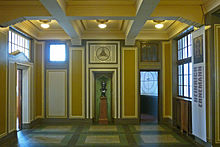Ernemann works

The Ernemann-Werke are a listed complex of production and administration buildings for the optical industry in Dresden-Striesen .
history
They were created from 1898 to 1938 in several sections between Schandauer and Glashütter Strasse on both sides of Junghansstrasse as the headquarters of Heinrich Ernemann, a stock company for camera manufacturing in Dresden .
In 1898, the original factory building was built on the west side of Junghansstrasse at the corner of Schandauer Strasse. In 1907, the four-storey brick building was given a mosaic on its tower-like corner projections representing the company's trademark - the light goddess designed by Hans Unger in 1903 .
Since this building had become too small despite several extensions, the owner Heinrich Ernemann commissioned the architects Emil Högg and Richard Müller in 1913 with the planning of a striking industrial building with a high-rise. Due to the First World War , the construction started in 1915 could only be completed in 1918 (Junghansstraße wing) and 1923 (Schandauer Straße with tower). The wing on Glashütter Straße was only added in a simplified form in 1938. A fourth wing, which was originally planned, was not realized.
description
It is a five- to six-storey three-wing complex with a staggered seven-storey corner project, on which a three-storey tower with an elliptical floor plan was placed. On top of it is a two-storey round domed structure surrounded by a viewing platform , which was originally intended as an observatory. The building is made of reinforced concrete and structured vertically by pilasters .
It is connected to the older building opposite in Junghansstrasse via a crossing on the second floor.
Hübner describes the 48 m high Ernemann Tower as one of the first high-rise buildings in Germany and as a representative of Dresden's reform architecture , which anticipated the style of New Objectivity (as it was designed before the First World War). Friedrich Löffler describes the tower accordingly as a “factory building in the style of New Objectivity”.
use
Until 1992 the factory was used by Pentacon for the production of cameras . The Technical Collections of the City of Dresden have been located in the building east of Junghansstrasse since 1993 . A department of the Dresden Social Welfare Office is housed in the building across the street from 1898.
Innovations in the factory
Based on the work of August Musger in Austria up to the experimental model kinetoscope, Hans Lehmann developed the slow motion at Ernemann . Both can be seen as co-inventors.
literature
- Fritz Löffler : The old Dresden. History of his buildings . EA Seemann Verlag, Leipzig 1981, ISBN 3-363-00007-3 .
- Ulrich Hübner et al .: Symbol and truthfulness. Reform architecture in Dresden. Verlag der Kunst Dresden Ingwert Paulsen jun., Husum 2005, ISBN 3-86530-068-5 .
- Matthias Donath and Jörg Blobelt: Old & New Dresden . edition Sächsische Zeitung, Dresden 2007, ISBN 978-3-938325-41-4 .
- Gilbert Lupfer, et al. (Ed.): Architecture Guide Dresden . Reimer, Berlin 1997, ISBN 978-3-496-01179-8 .
Web links
Individual evidence
- ↑ Kulturdenkmäler Junghansstrasse 2 and 3. Accessed on October 3, 2010.
- ^ Donath, p. 192
- ↑ Donath, p. 191
- ↑ Dresden architecture guide. quoted in das-neue-dresden.de
- ↑ Donath, p. 191
- ↑ Hübner et al., Pp. 10f
- ↑ Löffler, p. 444, image no. 542
Coordinates: 51 ° 2 '31.4 " N , 13 ° 47' 52.1" E


